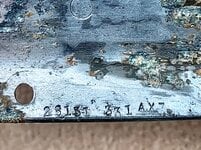GarfyB
Recruit
Hello,
I am really struggling to ID this aircraft part. It appears to be a channel for a sliding canopy, but also contains perspex/glass itself. This would suggest that this is part of a fixed canopy, which the main canopy slides over (does that make sense?), similar to a Spitfire, Miles Magister, Harvard, etc.
I've tried to get the Inspection stamps ID'd on another site, but with no success.
**Eidit: I forgot to mention that I found this near an Bomber Command OTU airfield ('43 - '46) in the south midlands of England.
Any help would be really appreciated.
Garth.
I am really struggling to ID this aircraft part. It appears to be a channel for a sliding canopy, but also contains perspex/glass itself. This would suggest that this is part of a fixed canopy, which the main canopy slides over (does that make sense?), similar to a Spitfire, Miles Magister, Harvard, etc.
I've tried to get the Inspection stamps ID'd on another site, but with no success.
**Eidit: I forgot to mention that I found this near an Bomber Command OTU airfield ('43 - '46) in the south midlands of England.
Any help would be really appreciated.
Garth.
Attachments
Last edited:







